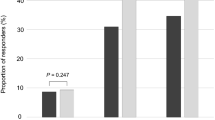Abstract
Lower urinary tract symptoms (LUTS) and erectile dysfunction (ED) are age-related conditions that may have a profound impact on the quality of life. The relationship between LUTS and ED is not completely understood. In this study, we assessed this relationship in men over 45 years of age during a prostate cancer screening program. LUTS and ED were evaluated in 1267 men aged 45–75 years (mean 58.2±8.2 years). Patients completed the International Prostate Symptom Score (IPSS) and the International Index of Erectile Function-5 (IIEF-5). The association between LUTS and ED was analyzed and the influence of age in the results was tested. We also evaluated the influence of the intensity of LUTS in the ED severity. A total of 514 (40.6%) patients were considered symptomatic of LUTS (24.8% with mild, 11.8% with moderate and 4% with severe LUTS). ED was present in 758 (59.9%) men and was considered mild in 25.0%, moderate in 18.3% and severe in 16.7%. The IIEF-5 score had a negative correlation with both the IPSS score (r=−0.33, P<0.001) and age (r=−0.31 and P<0.001). Age was positively associated with the IPSS score (r=0.14 and P<0.001). A significant correlation was observed between LUTS and ED, with 57.6% of the men with LUTS presenting ED as opposed to 29.7% of the asymptomatic population (odds ratio=3.32; 95% CI =2.57–4.29, P<0.001). Age-adjusted univariate analysis revealed a significant and independent influence of LUTS on the incidence of ED (odds ratio=2.72; 95% CI=2.08–3.57, P<0.001). IIEF scores varied significantly according to the severity of the urinary symptoms. Our findings in a prostate cancer screening population confirm that LUTS is an age-independent predictor of ED. Furthermore, they demonstrate that not only the presence of LUTS increases the likelihood of developing ED, but the severity of LUTS is associated with the intensity of ED.
This is a preview of subscription content, access via your institution
Access options
Subscribe to this journal
Receive 8 print issues and online access
$259.00 per year
only $32.38 per issue
Buy this article
- Purchase on Springer Link
- Instant access to full article PDF
Prices may be subject to local taxes which are calculated during checkout


Similar content being viewed by others
References
Feldman HA, Goldstein I, Hatzichristou DG, Krane RJ, McKinlay JB . Impotence and its medical and psychosocial correlates: results of the Massachusetts Male Aging Study. J Urol 1994; 151: 54–61.
Guess HA, Arrighi HM, Metter EJ, Fozard JL . Cumulative prevalence of prostatism matches the autopsy prevalence of benign prostatic hyperplasia. Prostate 1990; 17: 241–246.
Melman A, Gingell JC . The epidemiology and pathophysiology of erectile dysfunction. J Urol 1999; 161: 5–11.
Barry MJ, Fowler Jr FJ, O'Leary MP, Bruskewitz RC, Holtgrewe HL, Mebust WK et al. The American Urological Association symptom index for benign prostatic hyperplasia. The Measurement Committee of the American Urological Association. J Urol 1992; 148: 1549–1557, discussion 1564.
Rosen RC, Cappelleri JC, Smith MD, Lipsky J, Pena BM . Development and evaluation of an abridged, 5-item version of the International Index of Erectile Function (IIEF-5) as a diagnostic tool for erectile dysfunction. Int J Impot Res 1999; 11: 319–326.
Rosen RC, Cappelleri JC, Gendrano III N . The International Index of Erectile Function (IIEF): a state-of-the-science review. Int J Impot Res 2002; 14: 226–244.
Leungwattanakij S, Roongreungsilp U, Lertsithichai P, Ratana-Olarn K . The association between erectile function and severity of lower urinary tract symptoms. J Med Assoc Thai 2005; 88: 91–95.
Shao Q, Song J, Guo YW, Lu WC, Du LD . Evaluation of sexual function in men with symptomatic benign prostatic hyperplasia]. Zhonghua Nan Ke Xue 2005; 11: 505–507.
Boyle P, Robertson C, Mazzetta C, Keech M, Hobbs R, Fourcade R et al. The association between lower urinary tract symptoms and erectile dysfunction in four centres: the UrEpik Study. BJU Int 2003; 92: 719–725.
Chung WS, Nehra A, Jacobson DJ, Roberts RO, Rhodes T, Girman CJ et al. Lower urinary tract symptoms and sexual dysfunction in community-dwelling men. Mayo Clin Proc 2004; 79: 745–749.
McVary KT . Erectile dysfunction and lower urinary tract symptoms secondary to BPH. Eur Urol 2005; 47: 838–845.
Moreira Jr ED, Lbo CF, Diament A, Nicolosi A, Glasser DB . Incidence of erectile dysfunction in men 40 to 69 years old: results from a population-based cohort study in Brazil. Urology 2003; 61: 431–436.
Paick SH, Meehan A, Lee M, Penson DF, Wessells H . The relationship among lower urinary tract symptoms, prostate specific antigen and erectile dysfunction in men with benign prostatic hyperplasia: results from the proscar long-term efficacy and safety study. J Urol 2005; 173: 903–907.
Bloch W, Klotz T, Loch C, Schmidt G, Engelmann U, Addicks K . Distribution of nitric oxide synthase implies a regulation of circulation, smooth muscle tone, and secretory function in the human prostate by nitric oxide. Prostate 1997; 33: 1–8.
Klotz T, Bloch W, Loch C, Engelmann U, Addicks K . Pattern of distribution of constitutive isoforms of NO synthase in the normal prostate and obstructive prostatic hyperplasia]. Urologe A 1997; 36: 318–322.
Golomb E, Rosenzweig N, Eilam R, Abramovici A . Spontaneous hyperplasia of the ventral lobe of the prostate in aging genetically hypertensive rats. J Androl 2000; 21: 58–64.
Hale TM, Okabe H, Bushfield TL, Heaton JP, Adams MA . Recovery of erectile function after brief aggressive antihypertensive therapy. J Urol 2002; 168: 348–354.
Tarcan T, Azadzoi KM, Siroky MB, Goldstein I, Krane RJ . Age-related erectile and voiding dysfunction: the role of arterial insufficiency. Br J Urol 1998; 82 (Suppl 1): 26–33.
Goldstein I . The mutually reinforcing triad of depressive symptoms, cardiovascular disease, and erectile dysfunction. Am J Cardiol 2000; 86: 41F–45F.
Author information
Authors and Affiliations
Corresponding author
Rights and permissions
About this article
Cite this article
Reggio, E., de Bessa, J., Junqueira, R. et al. Correlation between lower urinary tract symptoms and erectile dysfunction in men presenting for prostate cancer screening. Int J Impot Res 19, 492–495 (2007). https://doi.org/10.1038/sj.ijir.3901557
Received:
Revised:
Accepted:
Published:
Issue Date:
DOI: https://doi.org/10.1038/sj.ijir.3901557



